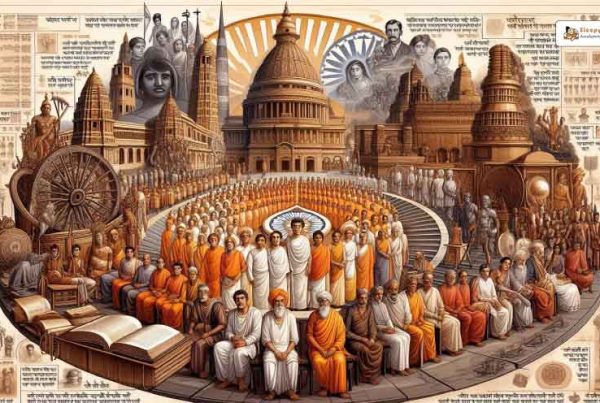The Gupta Empire, once a beacon of prosperity and power in ancient India, faced a dramatic decline and eventual disintegration. This article delves into the multifaceted reasons behind the fall of this illustrious empire, exploring both external and internal factors that contributed to its downfall. Let’s unravel the story of the Gupta Empire’s decline and disintegration, a tale marked by invasions, economic challenges, and internal strife.
Key Takeaways
- The Gupta Empire’s decline was influenced by both external invasions and internal weaknesses.
- The Huna invasions played a significant role in destabilizing the empire.
- Economic challenges, including the decline of Indo-Roman trade, weakened the empire’s financial base.
- Internal factors such as weak successors and political fragmentation further accelerated the decline.
The Rise and Expansion of the Gupta Empire
In the mid-3rd century CE, the Gupta Empire began to assert its authority in the middle Gangetic plain, following the decline of the Kushanas. Under the leadership of Chandragupta I, Samudragupta, and Chandragupta II, the Guptas established a vast empire that extended its influence across India. By the mid-5th century, the Gupta Empire had reached its zenith, with its power felt as far south as the Pallavas.
The Huna Invasions: A Major External Threat
One of the most significant external factors contributing to the decline of the Gupta Empire was the repeated invasions by the Hunas. The Hunas, a Central Asian tribe, became powerful around the mid-5th century CE. They made inroads into Iran and Persia, crossed the Hindu Kush mountains, and occupied Gandhara. Although Skandagupta managed to repel their initial attacks, the successive Gupta rulers were unable to withstand the repeated Huna invasions.
Impact of the Huna Invasions
- Trade and Commerce Decline: The invasions disrupted trade routes, particularly the Indo-Roman trade, depriving the Guptas of a crucial source of revenue.
- Law and Order Deterioration: The repeated attacks led to a breakdown in law and order, further weakening the empire.
- Political Fragmentation: The Hunas were eventually defeated by Yashodharman of Malwa, but their invasions had already sown the seeds of political fragmentation within the empire.
Economic Challenges and Decline
The Gupta Empire faced significant economic challenges that contributed to its decline. The decline in Indo-Roman trade was particularly detrimental. Disturbed conditions made it difficult to carry out trade, and the decline of Roman demand for Indian silk further impacted the economy. Additionally, the Eastern Roman Empire’s own decline reduced trade opportunities.
Internal Economic Struggles
- Revenue Loss: The decline in trade deprived the Gupta Empire of an important source of finance.
- Land Grants: The practice of granting land to officials and scholars reduced the state’s revenue base, further weakening the empire’s financial stability.
Internal Factors: Weak Successors and Political Fragmentation
Internal factors also played a crucial role in the decline of the Gupta Empire. After Skandagupta, the successive Gupta rulers were weak and unable to cope with the external and internal challenges. The crisis of succession further exacerbated the situation, leading to disputes and weakening the central authority.
Political Fragmentation
- Feudal Polity Weaknesses: The inherent weaknesses of the feudal polity became apparent as local chiefs and kings began asserting their authority, leading to political fragmentation.
- Hereditary and Multiple Posts: The concentration of power in hereditary and multiple posts further weakened the central authority. Officials holding multiple positions became powerful and influential, often acting independently of the central government.
The Final Blow: The Decline of Military and Financial Strength
The repeated Huna invasions, internal revolts, and economic decline deprived the Gupta Empire of its military and financial strength. The state struggled to collect revenue and pay officials, leading to further disintegration. The rise of regional powers, such as the Vakatakas in central India, further eroded the Gupta Empire’s influence.
Conclusion
The decline and disintegration of the Gupta Empire were the result of a combination of external invasions, economic challenges, and internal weaknesses. The repeated Huna invasions, decline in trade, weak successors, and political fragmentation all played a part in the empire’s downfall. By the mid-6th century, the Gupta Empire was confined to eastern Uttar Pradesh and Bihar, known as the Later Guptas, with Pataliputra as their capital. The story of the Gupta Empire serves as a reminder of the complexities and vulnerabilities of even the most powerful empires.
For more informative blogs on UPSC preparation, Click Here!







